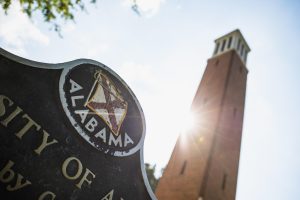You’re a UA transfer student. Here’s what you should know
August 4, 2021
This story was featured in Horizons, a special edition of The Crimson White for freshmen and transfer students. Horizons can be found on newsstands across campus, or online here.
The stress that transfer students encounter is unique. While freshmen have their own orientations and communities on campus, it can be difficult for transfer students who are expected to already understand college life.
More than 1,200 students transferred to The University of Alabama in 2020. Transfer students made up about 3% of the student population last year. For transfers who might feel isolated in the first few weeks of the semester, here are some tips to find a home in the UA community.
Join one of the 600+ student groups on campus
The University of Alabama has more than 600 student organizations to meet a student’s interest. While the abundance of options may seem daunting, one UA department provides a way for students to find a community that fits.
Located on the third floor of the Ferg, The SOURCE, an imprint of Student Involvement, is a department that helps students find interests and groups on campus by providing resources, support and recognition to the hundreds of organizations at the University.
The SOURCE keeps a record of information about UA clubs, including its mission and leadership. This makes it easy for students to visit their offices or websites and find out which organization is the best fit for them.
Even if the University doesn’t have a club that interests you, The SOURCE has made it easy for students to start their own.
To scope out many of these organizations in the span of a few hours, students can attend Get On Board Day, an event that highlights organizations on campus. This year, GOBD will be hosted on Thursday, Aug. 26, from 5 p.m. to 9 p.m.
During GOBD, student organizations set up tables with poster boards, free goodies, food and more around the Ferg. At the tables, representatives from each club inform interested students about their organization’s plans for the semester.
Mollie Tinney, the assistant director of organization engagement at The SOURCE, said she recommends attending GOBD if students want to get connected.
“We know it can be difficult for transfer students to find their place on a new campus,” Tinney said. “Attending GOBD is the perfect way to jump right in, meet lots of new people and learn about a wide variety of involvement opportunities.”
Ella Portwood, a UA senior majoring in communications who transferred from Shelton State Community College in 2020, said GOBD is a great resource for transfer students to acclimate themselves.
“Go to Get On Board Day. It’s not just for freshmen,” Portwood said. “You have nothing to lose and everything to gain.”
Organization Take Over happens the week after GOBD and lasts for two days inside the Ferg. During this time, student organizations take over the Ferg from 5 p.m. to 9 p.m. to host their first meetings, meet and greets, demonstrations, workshops and performances.
Stay connected with Bama Transfers
Bama Transfers is a program within First Year Experience, another program within the Division of Student Life, that provides first-year students with resources to transition academically and socially to campus. Both offices are located in Russell Hall.
Bama Transfers offers opportunities for transfer students to meet one another, engage in leadership opportunities and connect to the campus community. Often, this includes hosting free events to connect students like luncheons, movie nights or panel discussions.
Kiara Summerville, the assistant director of First Year Experience, said Bama Transfers supplies resources to students who don’t fit the mold of first-year freshmen.
“We recognize and celebrate that although transfer students are not new to the college experience, they are new to UA,” Summerville said.
For those interested in mentorship, Bama Transfers has a program called Transfer Engagement and Academic Mentors. Through TEAM, prior first-year transfer students mentor new transfers through their new experience. Transfer students can request a chat with a TEAM member by visiting the Bama Transfers webpage.
Bama Transfers also supervises Transfer Affinity Groups, which are small-group communities of transfer students with shared identities or shared academic interests community, including students of color, first-generation students and out-of-state students.
In addition to membership in these groups, all first-year transfer students will get a monthly or biweekly Transfer Connection E-Newsletter delivered to their Crimson email addresses from FYE. Every edition of Transfer Connection contains a calendar of events and involvement opportunities. It also highlights academic programs and outstanding transfer students.
To stay connected with Bama Transfers, check out their Instagram, @transfersatUA.
“There are so many ways that transfers can get involved through our office,” Summerville said. “We are happy to be the starting point for their UA experience.”
Under the Division of Student Life, University Programs will also host Weeks of Welcome. From Aug. 15 to 28, events for academic success, health and wellness, and diversity, equity and inclusion will be available for freshmen and transfers.
More information and a schedule will be published on the UP website, Twitter, Facebook and Instagram @UAWhatsUP.
Utilize the resources available to you
The University also provides a program that assists students who need resources beyond making friends.
TRIO, the federally-funded grant and outreach program sponsored by the U.S. Department of Education, provides opportunities for students who are first-generation, have limited income or have a disability by hosting exclusive gatherings, activities, academic tutoring and mentoring.
Since the program is federally funded, every university has at least one of TRIO’s eight programs, and The University of Alabama is no exception. The Capstone Center for Student Success has TRIO’s Student Support Services Program located in Russell Hall.
Wendy Cogburn, the manager of the University’s Student Support Services, said the program provides success coaching, academic advising, personal and professional development workshops, one-on-one and group tutoring, peer leadership opportunities, cultural enrichment activities and more.
Cogburn said transfer students can benefit from the TRIO program.
“We serve several UA students who have transferred from other schools or community colleges, and many were also part of the [Student Support Services] TRIO program at their previous school,” Cogburn said. “These transfer students have a high retention and graduation rate after participating in the [Student Support Services] TRIO program at UA.”
However, a student must submit an application to be accepted into the program. Acceptance into the program depends on the number of participants who have graduated, but the program admits between 40 and 50 new students each fall.
Russell Hall offers other services that students can benefit from, whether they’re a transfer or not. It houses the Capstone Center for Student Success, which provides a network of support services, including academic coaching, individual and small-group tutoring, computer labs and student study spaces.
“When students take advantage of all the resources available to them and then commit to doing their personal best, success is inevitable,” Cogburn said.
No matter if a student is a first-generation freshman or a fifth-year student, everyone gets the back-to-school jitters. With knowledge of resources from The SOURCE, Bama Transfers, TRIO and more, a transfer student can enter the fall semester confident in their decision and ready to make great memories at the Capstone.





















